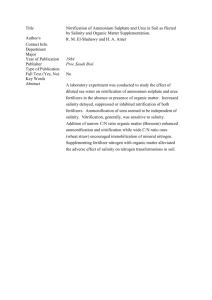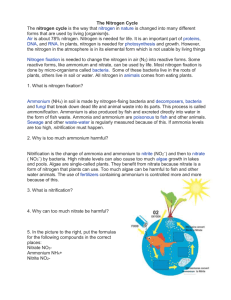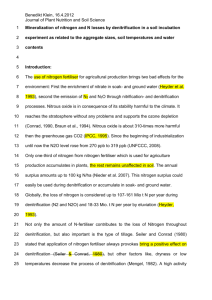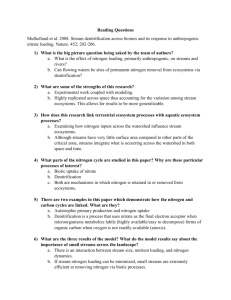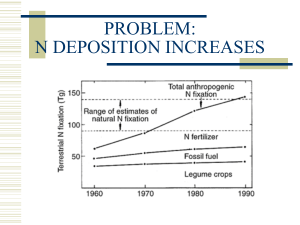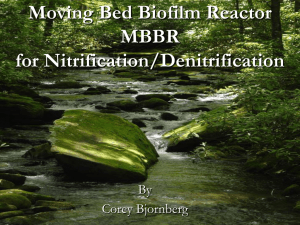Title NITROGEN AMMONIA REMOVAL FROM
advertisement
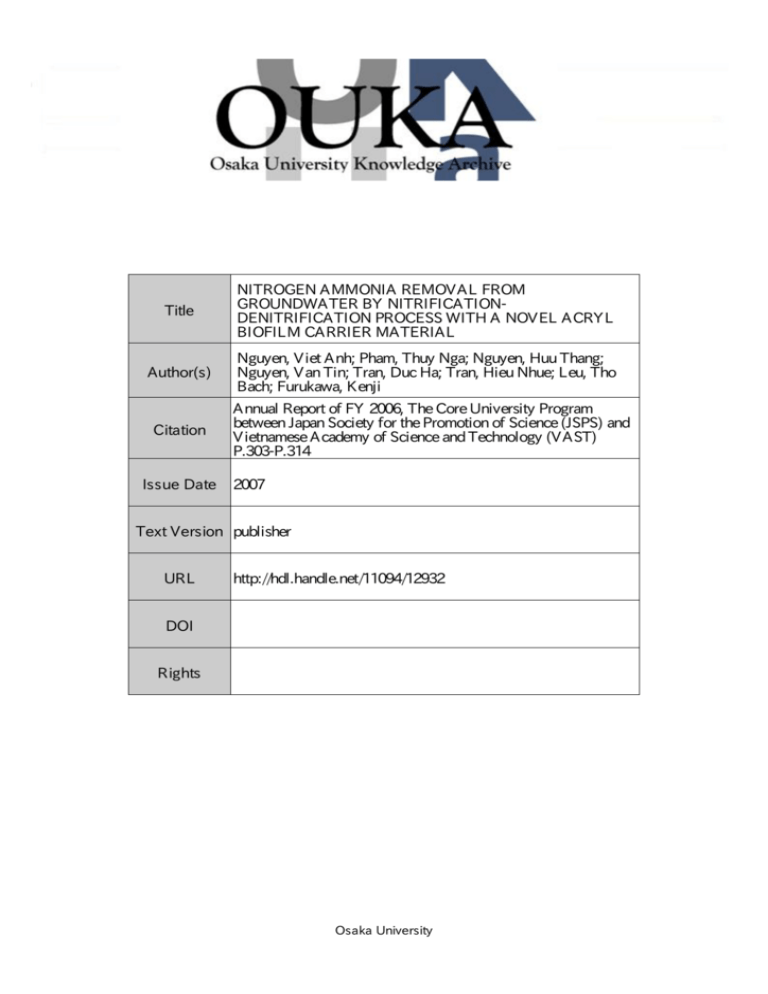
Title
NITROGEN AMMONIA REMOVAL FROM
GROUNDWATER BY NITRIFICATIONDENITRIFICATION PROCESS WITH A NOVEL ACRYL
BIOFILM CARRIER MATERIAL
Author(s)
Nguyen, Viet Anh; Pham, Thuy Nga; Nguyen, Huu Thang;
Nguyen, Van Tin; Tran, Duc Ha; Tran, Hieu Nhue; Leu, Tho
Bach; Furukawa, Kenji
Citation
Issue Date
Annual Report of FY 2006, The Core University Program
between Japan Society for the Promotion of Science (JSPS) and
Vietnamese Academy of Science and Technology (VAST)
P.303-P.314
2007
Text Version publisher
URL
http://hdl.handle.net/11094/12932
DOI
Rights
Osaka University
Osaka University
NITROGEN AMMONIA REMOVAL FROM GROUNDWATER BY
NITRIFICATION - DENITRIFICATION PROCESS WITH A NOVEL ACRYL BIOFILM
CARRIER MATERIAL
Nguyen Viet Anh\ Pham Thuy Nga\ Nguyen Huu Thang\ Nguyen Van Tin\
Tran Due Hal, Tran Hieu Nhue\ Leu Tho Baehl, Kenji Furukawa2
(1)
1
Centre for Environmental Engineering of Towns and Industrial Areas (CEETIA),
Hanoi University of Civil Engineering, Hanoi, Vietnam.
2
Department of Civil Engineering and Architecture, Kumamoto University, Japan.
Corresponding author. Address: CEETIA, DHXD, 55 Giai Phong Road, Hanoi, 10000, Vietnam.
Tel. (+84)-4-8698317, (+84)-913209689. Fax. (+84)-4-6281580.
E-mail.vietanhctn((j).yahoo.com.vietanhctn@gmail.com.
Abstract
Groundwater in the aquifers of Hanoi is polluted with nitrogenous compounds predominately in the form of anunonium -N (up to
30 mg/L). Microbiological removal of nitrogen compounds by nitrification followed by denitrification could be most appropriate
technology for Hanoi. This study focuses on development of nitrification - denitrification process for nitrogen anunonia removal
from ground water by using a novel acryl fiber (Biofill, NET Co. Ltd., Japan) for fixed-bed media. Results show that: with
influent concentration of anunonium 20 mgIL, hydraulic retention time HRT 1 11 in nitrification reactor, a stable ammonia-N
removal can be achieved with average efficiency 98.7% (93.2 - 99.9%). Nitrogen loading rate NLR = 0.01 - 0.62 kg N-NH/I
(m3 .day). Alkalinity was necessary to be added in the form of NaHC03 with minimum concentration of 50 mgIL. In
denitrification reactor, a required HRT to achieve stable removal of nitrate was 2 h. Average removal efficiency of nitrate was
94.2% (90.09 - 98.37%). NLR = 0.04 - 0.16 g N-N0 3-1 (g VSS.day) or 0.09 - 0.39 kg N-N03-/(m3 .day). Required ratio of
sodium acetate CH3COONa as a carbon source to be added per equivalent nitrogen removed CODIN = 6.92. Remaining
concentration of COD, anunonium and nitrite were major concerns of denitrification process effluent. Post treatment by aeration
and fUtration are suggested to be introduced after denitrification. Research results show positive results and open a promising
solution for groundwater quality improvement in Hanoi city.
Keywords: Ammonium, COD, denitrification, ground water, Hanoi, nitrification, nitrogen, water treatment.
1. Introduction
Existing situation oj groundwater pollution by ammonium in Hanoi area
Over the last ten years the population of Hanoi has increased rapidly to more than 3 millions people. In the
city there is an intensive exploitation of groundwater for domestic and industrial purposes. The Hanoi water
business company is exploiting main well fields with about 150 wells for the 10 water treatment plants with
the total production capacities of 400,000 to 450,000 cubic meters per day (see Figure 1). Beside that, there
are more than 500 industrial production wells with smaller capacity that are exploited by enterprises,
research institutes, hospitals, school units ... with approximately 50,000 to 60,000 cubic meters per day
exploited in the city. All around city there are more than 100,000 small bore wells (so called UNICEF
wells) with total capacity of about 200,000 cubic meters per day. Thus, the total volume of groundwater
exploited in Hanoi area is up to 600,000 - 650,000 cubic meters per day. This volume is nearly reaching a
limit of groundwater availability for the city. Under such intensive and exhausting exploitation the
groundwater resource is facing the serious risk of table depletion and quality deterioration.
-303-
(Hanoi Water Business Company, 2004).
In recent years, ammonium concentration in the groundwater in Hanoi has become an increasing problem
for water quality management in the city. The most heavily polluted areas are located mainly in the
southern part of the city where nitrogen ammonia concentrations range from 20 to 30 mgIL. There is still no
clear explanation of the ammonium origin in the ground water of Hanoi. Backward sewerage and drainage
system, inadequate wastewater and solid waste disposal and treatment, besides development of intensive
agriculture and industrial production in current period are being discussed as the pollution sources, while
some other specialists explained it based on the nature of the Hanoi hydrogeology. Geological and
hydrographic conditions in the Red delta are very complicated. Hydro geological "windows" between
permeable soil layers and the river bed, between upper and lower aquifers supporting some endosmosis
processes, unsealed old and fallow monitoring and production water wells, etc. may transfer pollutants from
surface to groundwater. All the reasons mentioned above may lead to a high pollution risk of nitrogen
compounds in the unique water source of the city.
According to the results drawn from different previous studies (Ha C.T., 2004, HWBC, 1997 - 2004),
ammonium content in water of the aquifers is changing from trace to 30 mgIL. Most of the areas are
polluted by ammonium as Phap Van, Dinh Cong, Ha Dinh, Kim Giang, Tuong Mai, Bach Mai, Bach Khoa,
Kim Lien, Quynh MaL Among of them, some areas are lightly polluted as Luong Yen, Yen Phu, Ngo Si
Lien, Don Thuy. Besides, some areas have a sign of pollution as Ngoc Ha, Mai Dich. In general, the
strongly polluted areas are mainly located in the south and the center. There is the highest pollution (~ 20
mg/L) in Phap Van, after that in Ha Dinh area (~ 12 mgIL), Tuong Mai (~ 10 mgIL). It is worth to note that
in the monitored areas, the nitrate and nitrite content are not high, meeting drinking water standard (See
Figure 2).
-304-
Figure 2. Concentration of nitrogen compounds in main water treatment plants in Hanoi city
==al
25:0
E
C
<)
~....
20.0
,~
C
0
t)
15.0
"C
C
:::I
0:)
c..
E
0:)
10.0
0
Z
5:0
fl.O
::-
'iii
:Ie
'"D-
g
E:
.".
a.
.t::
Cl
l:
I-
E:
~
~
.3
E:
.r:
::J
Gi
.ID
iii
.0
Cl
I:
"..
:z:
::I.
;,:
DE:
~
,.".
:z:
o0-.
zCl
!:I.:
.r:
.1:'
c·
~"Gr
c:
'0;
'iii
S
~
0
:Ii!
E
Z
(Ha C.T. et aI., 2004)
Presence of nitrogen compounds in water may cause some dangerous diseases for water users. Nitrate can
cause lacks of vitamin and is able to combine with amine to create the nitrosamine to cause cancer for
elderly. The newborn babies are highly sensitive to nitrite which is entered by the mother's milk, or by
water used for making the milk formula. After entering the body, nitrate will be transformed into nitrite by
intestine bacterium. Nitrite ion is more dangerous than nitrate for the people health. When reacting with
amines or alkyl in the body, they can form the nitrogen compounds causing cancer. Nitrites will affect
hemoglobin (Hb), which is responsible for carrying oxygen, and, tum it into methemoglobin (Mel-Hb),
which can not carry oxygen. Thank to the special enzyme, Mel-Hb will change into oxygen - hemoglobin
(oxygen-Hb). In small children, Mel-Hb can not change into oxygen-Hb because their enzyme systems are
not completely grown. In small children, liquid in their stomach is little; the bacterium creates a lot of
nitrite. On the other side, their stomach has few acids to prevent nitrate from turning into nitrite. Therefore,
.a big content of nitrite take hemoglobin and change it into Mel-Hb. This causes a loss of ability of oxygen
transfer to the tissues and therefore causes the diseases for the babies (Viet Anh N., 2001).
Ammonium in groundwater reduces antiseptic efficiency as it reacts to chlorine to create chloramines,
which antiseptic capacity is much lower than chlorine (about 1000 times). Additionally, it lowers ability of
iron and manganese removal by traditional treatment technology.
Ammonium is an important nutrient. Its elevated concentration can create favorable conditions for intensive
growth of aquatic organisms, including algae, which leads to deterioration of commodity water quality,
especially its clarity, smell, taste and bacterium contamination .
. Before 2002, in Vietnamese standard, the ammonium content in the supply water was required to be lower
than 3 mg/L. Since April 2002, according to the new standard No. 1329/2002 - QDIBYT, the ammonium
content must be under 1 mg/L, equal to the World Health Organization (WHO) standard. The standard of
the European Union for ammonium is under 0.5 mgIL. (See the Table 1).
-305-
Table 1. The Vietnamese and international standard for nitrogen compounds in supply water
EC standard
EPA
WHO
Vietnamese standards
Parameter
Unit Standard (S0177S/EEC) Guidelines
(1993)
(1)
(2)
(3)
MCL GL
MAC
a
Ammonium CNH4+)
0.5
3a
1.5
3
1.5 a
t{itrate (t{03-)
50
44.3
25
6(asN) 22.1
50
50
t{itrite (t{02-)
0.1
3
0
0
3
4.4
COD (KMn04)
2
2
mgIL
2
:it
(1) - 20 TCN 33-85: Construction code issued by Ministry of Construction (1985).
(2) - Vietnamese Standard TCVN 5501-91 for drinking water quality (1991).
(3) - Vietnamese Standard 132912002 - BYT/QD issued by Ministry of Health (2002).
a - Ground water.
MCL - Maximum contaminant levels.
GL - Guidelines.
MAC - Maximum acceptable concentration.
(Ha C.T. et aI, 2004).
Methods for ammonium removal from water
In groundwater, nitrogen compounds may exist in organic, nitrite, nitrate and ammonium compounds.
Many technologies have been tested and applied by many countries: air striping, break-point chlorination,
bio-chemical nitrification - denitrification, ion exchange, electrochemical methods, reverse osmosis,
electrodialys, distillation (Viet Anh N., 2001).
However the treatment technologies for nitrogen ammonium removal from groundwater supply are still
unknown not only to Vietnam but also to many other countries in the world, especially at raised ammonium
concentration of 10 - 20 mg/L. This is a reason to promote this research. It is needed to find an appropriate
method of high efficiency, stable operation, acceptable cost where treated water should meet the
Vietnamese water quality standards. Experiences from number of researches over past years have shown
that biological oxidation (nitrification) in aerated submerged bioreactor followed or not followed by
denitrification (depending on initial concentration of nitrogen ammonia) is recognized as a promising
method. The main advantages are: no additional treatment steps and not expensive.
Bio-chemical processes of nitrogen transformation
At first, ammonium is oxidized to nitrite by oxidizing bacteria of Nitrosomonas (step 1). After that Nitrite
ions are oxidized to Nitrate by Nitrobacter, Nitrospira, Nitrococcus and Nitrosocystis (step 2) (Henze,
2002). Nitrifying species belong to group of autotrophic micro-organisms which use energy generated from
nitrification reaction where nitrogen ammonia is an electron donor for building up of their cells. Carbon
source of new cell production is inorganic carbon (HC03} Besides, they consume oxygen intensively.
NH: +~02
2
NO- + ~ 0
2
2
Ammonium oxidyzing bacteria
>NO; +2H+ +H 20+276+351KJ (1)
Nitri~xidyzing bact~ NO 2
(2)
3
By combining (1) and (2):
NH: +202 ----?NO; +2H+ +H20
(3)
With metabolic process consideration we have (Gujer, 1974):
1.02 ~ + + 1.S902 + 2.02 HC03 ---->
(4)
0.021 CsH7 02N + N0 3- + l.92 H 2C03 + 1.06 H 20
306-
That process is normally implemented in a biological reactor with attach-growth biomass on carrier media.
Formation of biofilm on the surface of carrier material enables the increase of biochemical reactions and
increases of activated sludge age.
Rate of oxidation process depends on sludge age, temperature, pH, food per microorganism (F/M) ratio,
initial ammonium concentration, dissolved oxygen concentration, media characteristics, etc. Nitrifying
bacteria have limited integration capability, thus selection of carrier media plays an important role in the
treatment efficiency and the composition of the biochemical reaction products. Using appropriate carrier
material for biofilm attach-growth may bring to retaining of biomass on the carrier media, increase of
sludge age, increase and keeping of stable treatment efficiency in the same reactor volume, as well as
enabling resistance of the system from possible shocks due to changes of environmental conditions.
For elimination of nitrate, heterotrophic bacteria convert nitrate into atmospheric nitrogen under anaerobic
conditions. Nitrate is the oxidizing agent, which gives the process the name of anoxic. This process requires
electron donors which could be organic compounds, H2S, etc. If there is no presence of dissolved oxygen
but there are biodegradable organic matters available, the heterotrophs can utilize nitrate as oxygen source
for oxidation of organics (electron donor) while the nitrate (electron acceptor) is reduced into nitrogen gas
as in following equation:
N0 3- + organics + bacteria -+ N2 + CO 2 + H 20 + biomass growth
(5)
In fact the denitrification process is a combination of the series of the four steps:
(6)
Bacteria receive energy for their growth from denitrification process of N03- into N2 while they need a
carbon source for the cell reproduction. Thus, during denitrification process, an additional carbon source
may be needed. The common carbon sources are natural gas (methane containing), alcohol, sugar, sodium
acetate, acid acetic, etc. where sodium acetate is one among most suitable additives. The reaction is as
follows:
4N03- + CH3COONa -+ 4N02- + 2C02 + H 20 + NaOH
After that:
(7)
2N02- + CH3 COONa -+ N2 + 2C02 + H 2 0 + NaOH
Combining two processes:
(8)
4N03- + 3CH3COONa -+ 2N2 + 6COz + 3HzO + 3NaOH
(9)
As nitrifying bacteria are slowly growing organisms and will thus be washed out of continuous flow
reactors unless they are effectively immobilized. A high cell concentration is possible with immobilized
biomass, which enhances volumetric efficiency. This allows for relatively small reactors and often offers
protection from toxic shocks and adverse temperatures which would help to maintain stable treatment.
2. Materials and methods
Experimental model for study on nitrification and denitrification process is presented in Figure 3 and Figure
4.
Figure 3. Scheme of ammonium removal experiment
Feeding water
1'1 efflu enttan k
Solution
preparation
tank
t
C source
-307
Den itrifi cati on
reactor
Figure 4. Experimental model at CEETIA Laboratory
I Airfiowmeasurement I
I
Nitrification reactor
Dosing pump
Feeding lankfor
nitrification
Feeding tank for
denitrification
The nitrification reactor
For effective microbiological nitrogen ammonia elimination from groundwater, one of the critical factors is
the selection of the aeration process (in nitrification reactor) and the filtration material. It was analyzed that
by using fixed bed by acrylic resin for attached growth of nitrifying bacteria (autotrophic micro-organisms)
such as Nitrosomonas and Nitrobacter and indirect introduction of saturated dissolved oxygen into fixed
bed chamber, some advantages could be achieved, such as reduction of head loss compared with direct
filtration through media from minerals, increase of contact surface areas between substrate and
microorganisms, reduction of risk of wash-out by air-flow of biomass into following treatment steps, and,
stable treatment efficiency. This study focuses on the development of the nitrification process by using a
novel acryl fiber (Biofill, NET Co. Ltd., Japan) (See Figure 5) and indirect air introduction into filtration
chamber.
Figure 5. Acrylic carrier
material Biofill Net
The nitrification reactor made by plexiglas has a rectangular
shape of dimensions ofB x Lx R = 10 x 14.5 x 40 cm, total
volume of 5.8 L. The reactor is fed by substrate which is
prepared from tape water, kept in plastic tank, rest for few
hours for residual chlorine releasing, and then added with
synthetic solutions as shown in Table 2 (Cao T.R et aI, 2001,
Okabe S. et aI., 2002) in order to achieve ammonia nitrogen
concentration of 20 and 40 mg/L. Seeding sludge for biomass
growing has been taken from activated sludge plant. The
feeding solution was introduced into the reactor in a complete
mixed and continuous regime 24/24h using a peristaltic pump
and aquarium air blower. The air flow was measured and
adjusted by a flow meter device. The reactor was covered by a
black cloth to prevent from sun breathing and algae growth.
Ambient temperature was kept at 20 - 25°C. Reactor was put
into operation from February 2003 to July 2004.
308-
The denitrification reactor
Denitrification reactor - cylinder made by plexiglas had a diameter of 200 mm and height of 500 mm,
making total volume of 13.2 L. The same media of acrylic resin of Biofilm Net was used for the
denitrification media. Nitrified water kept in a intermediate tank and mixed with additional sodium acetate
as a carbon source is pumped into the denitrification reactor in up-flow regime. The model was operated
continuously from February 2004 to July 2004.
Preparation of sludge
Nitrifying activated sludge was collected from running wastewater treatment plant at one hotel in Hanoi
city for the sludge seeding. Acclimatization period for sludge growth and stabilizing in the reactors was
approximately 2 months. Even distribution of the sludge on the whole surface area of the media in a whole
reactor was one among advantages of the novel carrier material.
Preparation offeeding substrate
Synthetic substrate for the reactor feeding was prepared from tap water mixed with chemicals as described
in the Table 4 in order to achieve ammonium concentration in the feeding substrate about 10, 20 and 40
mglL. Alkali content added into the feeding was varying from 400 mg/L to 30 mg NaHC031L, and kept at
50 mglL as the minimum content required.
The feeding solution for the denitrification reactor was the effluent from the nitrification one added by
organic matters as carbon source. In the first period, acetic acid was tried as a carbon source. In the
following periods, sodium acetate was introduced instead of acetic acid at concentration varying from 260
to 400 mg/L to achieve the ratio of CODIN = 5 - 6 (Henze, 2002). That elevated CODIN ratio may help to
avoid possible starvation of microorganisms and to remove soluble oxygen (if any) from the effluent liquid
which negatively impacts on the following denitrification process.
Table 2. Constituents in feeding substrate for the nitrification reactor
Chemicals
K 2HPOdH20
Concentration (mg/L)
152.8 (from 12/2002 to 2/2003); 76.4 (from 2/2003 to 7/2004)
100
28.4 (from 12/2003 to 2/2003); 0
91.7
NaHC03
From 400 (from 12/2003) to 50 (from 16/3/2003)
~CI
MgS0 4 .7H2 O
CH3COONa.3H2 O
Operational regimes
Operational regimes of the system are shown in Table 3 and Table.
Table 3. Operational regimes of nitrification experiments
Periods
Operational regimes
20/12/2002 - 20/1/2003
(i) Growing sludge, acclimatization step
20/1/2003 - 12/5/2003
(1) ... (3) HRT=21.2 h, N-NH/ in = 20 ... 40 mg/L, NaHC0 3 = 0 mg/L
12/5/2003 - 23/7/2003
(4) ... (10) HRT=21.2 h, N-~+ in = 20 mg/L, NaHC03 = 400 ... 50 mg/L
23/7/2003 - 29/7/2003
(11) HRT=16 h, N-~+ in= 20 mg/L, NaHC03 = 50 mg/L
29/7/2003
(12) HRT=8 h, N-~+ in = 20 mg/L, NaHC03
8/8/2003
-309-
50 mglL
8/8/2003 - 1118/2003
(13) HRT=6 h, N-NRt + in = 20 mg/L, NaHC0 3
50 mg/L
11/8/2003 - 14/8/2003
(14) HRT=4 h, N-NRt+ in = 20 mg/L, NaHC03 = 50 mg/L
14/8/2003 - 20/8/2003
(15) HRT=2 h, N-NRt+ in = 20 mg/L, NaHC03 = 50 mg/L
28/8/2003 - 27/8/2003
(16) HRT=1 h, N-NRt+ in = 20 mg/L, NaHC03 = 50 mg/L
27/8/2003 - 3118/2003
(17) HRT=0.5 h, N-NRt+ in = 20 mg/L, NaHC0 3 = 50 mg/L
1/9/2003 - 24/9/2003
(18) HRT=2 h, N-NH4+ in = 20 mg/L, NaHC03 = 50 mg/L
24/9/2003 - 4/10/2003
(19) HRT=2 h, N-NH4+ in = 10 mg/L' NaHC03 = 50 mg/L
4/10/2003 - 21/10/2003
(20) HRT=1 h, N-NH4+ in = 10 mg/L, NaHC03 = 50 mg/L
21110/2003 - 23/4/2004
(21) HRT=2 h, N-NH4+ in
20 mg/L, NaHC03 = 50 mg/L
23/4/2004 - 30/7/2004
(22) HRT=1 h, N-NH4+ in
20 mg/L, NaHC03 = 50 mg/L
Table 4. Operational regimes of denitrification experiment
Periods
Operational regimes
5/1/2004 - 16/1/2004
(i) Return flow. 0.02 - 0.16 L CH3COOHlI, HRT =5,5 h.
16/112004 - 9/3/2004
(ii) ... (iii) Return flow. 130 - 340 mg CH3COONa.3H20 /1, HRT =5,5 h
9/3/4004 - 28/3/2004
(1) 260 mg CH3COONa.3H20/l, HRT =5,5 h.
28/3/4004
(2) 400mg CH3COONa.3H20 /1, HRT =5,5 h.
14/4/2004
14/4/4004 - 23/4/2004
(3) 400mg CH3COONa.3H20 /1, HRT =4,07 h.
23/4/4004
12/5/2004
(4) 400mg CH3COONa.3H20 /1, HRT =3 h.
12/5/2004 - 16/6/2004
(5) 400mg CH3COONa.3H20 /1, HRT =2 h.
16/6/2004 - 22/7/2004
(6) 400mg CH3COONa.3H20 /1, HRT =1 h.
22/7/2004 - 26/7/2004
(7) 400mg CH3COONa.3H20 /1, HRT =0,5 h.
26/7/2004 - 30/7/2004
(8) 400mg CH3COONa.3H20 /1, HRT =1 h.
The experiments were carried out at many different operational regimes (illustrated as in Table 3 and Table
4) in order to answer the following questions:
- Minimum allowable HRT which equals to minimum required reactor volume.
- Suitable chemicals and their minimum required dosing content, including substrate components, carbon
source, alkali, etc ...
- Factors which are affecting removal efficiency and stability such as temperature, alkalinity, dissolved
oxygen concentration, presence of inhibiting compounds such as iron, manganese, nitrite, etc.
3. Results and discussions
The nitrification model
1. Nitrogen ammonia concentration in the influent was about 20 mg/L, which equals to the highest
concentration in groundwater in some water plants in Hanoi. The removal efficiency was achieved from
93.2% to 99.9% (average 98.7%) at the minimum HRT of 1 h. Nitrogen ammonia concentration in effluent
was ranged from 0 to 0.53 mg/L.
-310-
2. In the setting up period, since concentrations of nutrients such as N, P available in groundwater are often
low, the nutrients need to be added into feeding solution. When the system operation has stabilized, adding
of the nutrients is not necessary. Time needed to reach stability of biological reactor was about 2 months
from the start of operation.
3. Acrylic carrier seems very suitable for carrier media for nitrogen removal in a biological reactors.
4. If initial ammonia concentration in groundwater is less than <11 mg/L, only nitrification process need to
be carried out. Otherwise, both of the processes needed to be carried out to reach allowable quality standard
of nitrate thanks to conversion of ammonium to nitrate (See Table 1).
5. The nitrogen ammonia loading rate (NLR) per unit volume of reactor was determined. That was NLR =
0.01 - 0.62 kg N-NH/I(m3.day) at the high and stable ammonium removal efficiency, from 93.2% to
99.9% (in average 98.7%).
6. After nitrification process, alkalinity and pH in effluent has been reduced as HC03- ion was used for
nitrification reaction (such illustrated as in equation (4». If alkalinity in the feeding substrate is not enough,
alkaline should be added. Theoretically, nitrification process can happen at pH = 7 - 7.8. If pH is less than
7, the nitrification process can be inhibited. The inhibition was checked in the first period wherein
alkalinity was not added into the reactor. Enough alkalinity in a stable environment can bring to high and
stable treatment efficiency. Minimum alkaline content that need to be added into the model using tap water
from CEETIA is 50 mg NaHC03 /I. More alkalinity did not increase the treatment efficiency while it equals
to more chemical expenses. Furthermore, high alkalinity dosing raises the pH value and increases
concentration of ammonium gas NH3 converted from soluble ammonium. It is well known that ammonium
gas is an inhibitor for the microorganism growth.
7. Dissolved oxygen DO value always was minimum, but still higher than 4 mg/L. If DO was low, content
of intermediate product nitrite was high. Nitrite was an inhibitor to removal efficiency. Temperature higher
than 20°C has been appropriate for the nitrification process. Temperature less than 20°C seemed to have a
disadvantage in treatment performance.
8. Exceeding sludge create negative effects on the treatment efficiency. In the last period, a lot of sludge in
the form of thick biofilm accumulated, leading to unfavorable FIM ratio and possible anaerobic conditions,
and, consequence reduced treatment efficiency (Fig 2/e). Sludge removal by introduction of air flow into
the media followed by sludge emptying can surmount this problem.
The nitrification model
1. The model had been operated from early February 2004 to last July 2004. After 6 months in operation,
the results showed that the model operated well and stably. Average denitrification efficiency was 95.1 %.
Minimum HRT needed to get high and stable removal efficiency (> 95%) was HRT = 2 h. IfHRT reduced
to 1 h or 0,5 h, treatment efficiency was low and unstable (90 - 95%). Nitrate concentration in the effluent
can meet the Vietnamese standard for drinking water which should be bellow 50 mgIL. However, if the
denitrification process happened completely, intermediate product of nitrite created in water was still high.
Nitrite is a toxic compound, inhibiting bio-organic transforming process. That could be a reason for
treatment efficiency which did not reach the maximum values.
2. pH in reactor was in a range of 6.89 - 8.19. Alkaline and pH values in the effluent were increased. The
addition of alkaline into the previous step of nitrification makes the denitrification to stabilize. The
theoretical optimum pH values for denitrification process are 7 - 8 (Ha C.T. et aI., 2001) what has been
confirmed by these experiments.
3. After treatment, nitrite in the effluent from the denitrification model was sometimes higher than that in
the standard (3 mg/L). In unsuitable pH, temperature, or in presence of inhibitor(s), the denitrification
reaction did not occur completely to produce an intermediate product of nitrite. It may be also due to the
remaining of ammonium in inflow before the denitrification reactor. Some solutions could be proposed
including increasing HRT and adjustment ofFIM rate, adding sodium acetate to utilize soluble oxygen in
water, and, introduction of aeration step after this treatment.
-311-
4. Concentrations of organic compounds utilized as the carbon source for reduction of nitrite and nitrate
processes (not including cells production) are calculated by the following equation:
(10)
wherein: We is an electron equivalent for organic compounds, glm3 (McCarty, 1969).
Converting from N-N0 2- and O2 to N-N0 3- equivalent concentration:
Cs = 0.357 We N-N03- eq
(11)
With metabolic process consideration:
(12)
In which Cr Cs'/Cs is consumption rate (McCarthy, 1969). Ifwe calculate organic compounds through
COD (mgIL), than We = 8g COD, from where:
(13)
Value of Cr is varying between 0.8 - 3.6 based on the chemicals used (Monteith, 1980).
In this study, while the denitrification process operated stably, the average CODin was 144.1 mgIL ± 1l.3
(st.dev.), CODout was 32.8 mgIL ± 9.6 (st.dev.), the average of compounds of Nitrogen (N-N03-eq) in
influent was N-N0 3-eq (in) = 17.0 mgIL ± l.6 (st.dev.), in effluent was N-N0 3-eq (out) =l.0 mglL ± 0.4
(st.dev.). Cr has been calculated as 2.42. The value was similar to that of other researches. Cr was higher
than 1 means that the organics consumption for cell building was more than consumption for denitrification.
That also shows the required organics ratio versus nitrogen concentration CODIN is about 6.92. From this
value we can determine necessary organic loads to be fed to the reactor in order to control the effluent COD.
5. We also determined values ofNLR in different operational regimes. NLR collected were in a range of
0.04 - 0.16 g N-N03/(g VSS.day). In this range, nitrate removal efficiency was high and stable (90.1 98.4%, the average of 94.2% ± 2.5 (st. dev.). Those values fit the range determined from international
experiences which are from 0.03 to 0.11 g N-N03-/(g VSS.day) (Henze, 2002, Ha C.T., 2004). When there
is enough organic substrate, the novel acrylic resin allows high density of the biomass, what may lead to
high treatment efficiency with higher nitrogen loading rates (NLR). However with NLR > 0.15 g N-NOJl(g
VSS.day) the removal efficiency was less than 95%. NLR was determined = 0.09 - 0.39 kg N-N03/(m3.d).
6. Carbon source added into denitrification process was sodium acetate. Adding acetic acid as carbon
source did not bring to good treatment efficiency as it created unfavorable conditions for microorganisms
(low pH and alkalinity). Besides, adding acetic acid also creates suitable conditions for undesired fungi
growth and bad odors in the waters.
7. Ammonium content in the effluent was higher than that in the influent may be because of anaerobic
disintegration of dead cells of microorganisms happened in the reactor. It can be solved by supplying air
after denitrification step to control ammonium, remaining organic compounds and odors control in the
effluent.
8. The efficiencies in both reactors were high and stable, which means that treatment technology of
ammonium in groundwater by the nitrification and denitrification with a novel carrier media of acrylic resin
is feasible. However, further research is needed for getting more information of the process and for
practical implementation.
-312-
Figure 6. Results of nitrogen removal experiments
(a)
(b)
Denltrlficatlon: Temp., pH, Alkal!nlty Graph
NHrlflcatlon: Temp., pH. Alkalinity Graph
i
§.
[
~
!
u
j
~
<i
"i.
i
~
-",-Tom
I--TOcut
~T'"
_pHIn
I __ !*lin
-:o:-pHcut
Dab
~Kiin
-pHw
__ Kiln
~Kl",
.-...r-Kiout
(c)
(d)
Nitrogen loading raIe(f\l..R) \IS. Re!rovaI efficiency(E) Qaph
0.000
0.100
0.19)
0.200
NLR, 9 N-NO.I(g VS5.d)
(e)
(f)
Denitrification
"""'_·»03-«.t
~-ErM",*,"l,%
(a)
(b)
(c)
(d)
(e)
(f)
Nitrification reactor: changes of temperature, pH, alkalinity;
Denitrification reactor: changes of temperature, pH, alkalinity;
Denitrification: Relationship between N-N03- (NLR, mg N-N03-/ g VSS.day) and removal efficiency (E, %);
Denitrification: Relationship between COD consumed and removal efficiency;
Nitrification rector: Ammonium removal over operation regimes.
Denitrification: Denitrification efficiency over last months.
4. Conclusion
The results from our experiments illustrated that the treatment of ammonium from polluted groundwater by
biological process including nitrification and denitrification process using acrylic carrier material is a
promising solution. This method has shown a high removal efficiency, reliability, stability and can be
applied perfectly. The results from research also provided a lot of important information to support next
study in a pilot scale and for applying of this method to the full scale in order to solve current crucial
problem for water supply in Hanoi city.
313
Acknowledgment
The authors express grateful to Hanoi University of Civil Engineering, especially to the Center for
Environmental Engineering of Towns Industrial Areas (CEETIA), for their support for this study. The
authors also express kindly to Join Program of Core Universities supported by the Japanese fund for
promotion of science and technology (JSPS) for providing us with the trip for studying, sharing and
exchanging international experience.
References
1.
2.
3.
4.
5.
6.
7.
8.
9.
10.
11.
12.
13.
14.
Cao The Ha, Le Van Chieu, Nguyen Van Khoi, Bui Van Mat and other colleagues (2004). Interim
report. Nitrogen ammonia removal from Phap Van water treatment plant. Hanoi.
Cao The Ha, Nguyen Van Khoi, Tran Hieu Nhue, Nguyen Quoc Cong (2001). Nitrogen ammonia
removal from Hanoi ground water by nitrification. Hanoi research project No. 0IC-09/11-2000-2.
Hanoi.
Gujer W. and Jenkins D. (1974). The contact stabilization process - oxygen and nitrogen mass balance.
Report No. 74-2. Sanitation Engineering Research Lab., Univ. of California, Berkley, USA.
Hanoi Water Business Company (2004). Feasibility study report. Construction of a new groundwater
treatment plant of Thuong Cat. (by personal communication).
Hanoi water business company (HWBC) (1997 - 2004). By personnel communications. Data from
water supply monitoring in Hanoi city.
Henze M., Harremoes P., Jansen J., Arvin E. Wastewater treatment. 3rd ed. Springer, 2002. pp. 89 - 99.
Kenji Furukawa, Joseph Rouse, Tran Rieu Nhue, Nguyen Van Tin, Nguyen Viet Anh, Do Hai, Leu
Tho Bach. Water quality survey of Vietnam. Annual Report of FY 2000. The Core University
Program between JSPS and NCST. Fujita Laboratory, Graduate School of Engineering, Osaka
University, Japan, 2002. pp. 80 - 93.
Nguyen Viet Anh (2004). Research project under the Hanoi University of Civil Engineering No. 3020041KHXD. Nitrogen ammonia removal from groundwater in Hanoi by using acryl resin filters
media.
Nguyen Viet Anh, Nguyen Van Tin, Tran Hieu Nhue, Leu Tho Bach, Furukawa K. First results from
experiments on nitrification of ammonia in ground water of Hanoi city. Proceedings of the 4th
General Seminar of the Core University Program: Environmental Science and Technology for
Sustainable Development. July 14 - 15, 2003. Osaka, Japan. pp. 206 - 210.
Nguyen Viet Anh. Methods for nitrogen ammonia removal from groundwater.
Journal of
Environmental Protection, Vietnam Environmental Protection Agency (YEP A), 3/2001.
Okabe S., Naitoh H., Watanabe Y. (2002). Structure and function of nitrifying biofilms as determined
by molecular techniques and the use of micro electrodes. Journal Water Science and Technology,
46 (1-2), 233.
Pollice A., Tandoi v., Lestingi C. Influence of aeration and sludge retention time on ammonium
oxidation to nitrite and nitrate. Journal Water Research, No. 36, 2002. pp. 2541 - 2546.
Tran Hieu Nhue, Nguyen Van Tin, Do Hai, Nguyen Viet Anh, Leu Tho Bach, Joseph Rouse, Kenji
Furukawa. Ground water contamination with nitrogenous compounds in Kumamoto Prefecture
and Hanoi city - Present conditions and adopted countermeasures. Annual Report ofFY 2001. The
Core University Program between JSPS and NCST. Fujita Laboratory, Graduate School of
Engineering, Osaka University, Japan, 2003.
Tran Hieu Nhue, Nguyen Van Tin, Nguyen Viet Anh, Do Hai. Assessment of ammonia removal
efficiency at water treatment plants in Hanoi city. Proceedings from Joint seminar on technologies
for nitrogen removal from ground water. CEETIA, Hanoi University of Civil Engineering Kumamoto University. Hanoi, 8 June 2001. pp. V.I - V.26.
314

